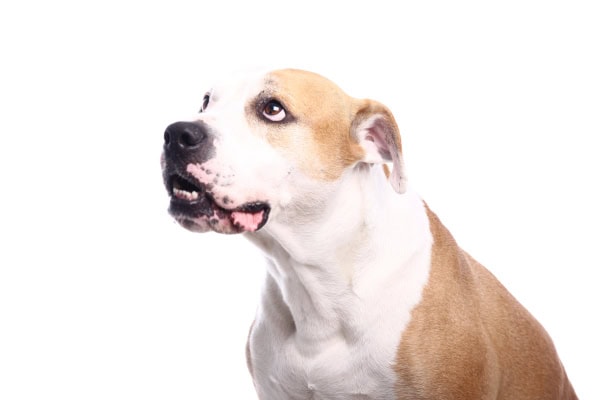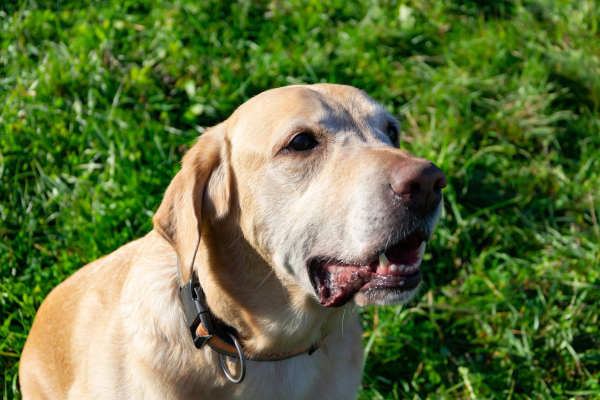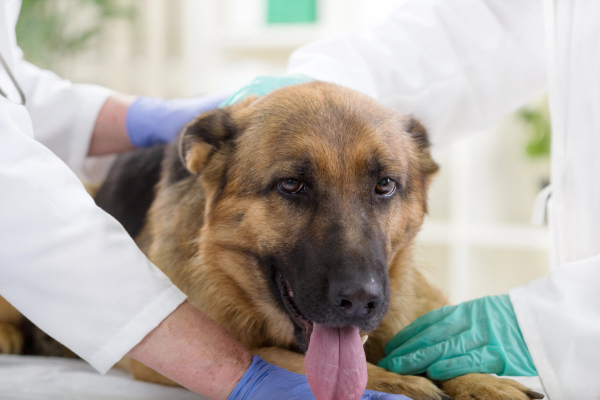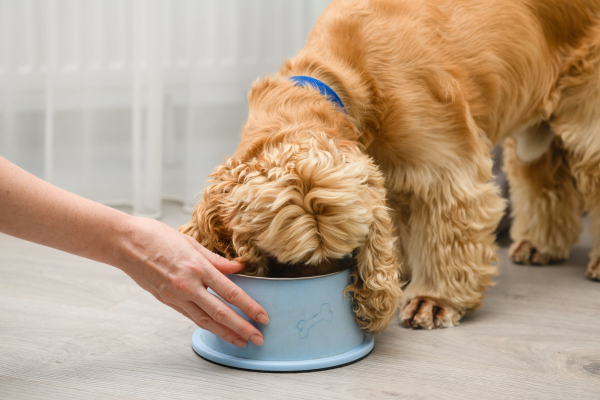Trigeminal neuritis in dogs (i.e. dropped jaw in dogs) affects a dog’s ability to use the jaw muscles to close the mouth. Integrative veterinarian Dr. Julie Buzby explains the signs, diagnosis, treatment, and prognosis to help clear up some of the mystery surrounding this disease.

Some conditions in dogs have subtle symptoms, but trigeminal neuritis is not one of them. The signs come on suddenly and are quite dramatic. Dogs who develop trigeminal neuritis—also called trigeminal neuropathy, trigeminal neuralgia, or dropped jaw in dogs—cannot close their mouths.
Seeing your dog’s mouth hanging open can make your jaw drop in surprise. But as you will soon discover, the outlook for dogs with trigeminal neuritis isn’t nearly as dire at it may seem.
What is trigeminal neuritis in dogs?
Trigeminal neuritis in dogs is a condition where the trigeminal nerve, which controls the jaw muscles, becomes inflamed, leading to the dog being unable to move his or her jaw. As a result, the dog’s mouth hangs open. This explains why trigeminal neuritis is also called dropped jaw.
Overall, trigeminal neuritis is the most common neurological cause of paralysis of the jaw in dogs.
To understand trigeminal neuropathy, we must take a look at the trigeminal nerve itself. There are 12 paired cranial nerves that provide motor and sensory functions for the head and neck. The trigeminal nerve is the fifth cranial nerve (CN V).
There are three branches of the trigeminal nerve. Two provide sensation to the eyes, nose, mouth, and face. And one branch, the one most clearly affected by trigeminal neuritis, provides both facial sensation and motor function to the chewing muscles (i.e. muscles of mastication).
However, in trigeminal neuritis, the trigeminal nerve becomes inflamed, which affects its function. Based on the jobs of the trigeminal nerve, it would only make sense then that trigeminal neuritis impacts a dog’s ability to move his or her jaw (and sometimes feel his or her face).
What causes trigeminal neuritis in dogs?
Trigeminal neuritis is an idiopathic condition that is usually bilateral (i.e. affecting both sides of the face). The word “idiopathic” means we don’t know what causes it. However, some vets believe that it could be immune-mediated or related to a viral infection.
Interestingly, in a study of 29 dogs with trigeminal neuritis, Golden Retrievers were overrepresented. But otherwise, no age, sex, or environmental factors (e.g. season of the year or recent vaccinations) seem to be linked to trigeminal neuritis.
Unfortunately, because we don’t know the underlying cause of idiopathic trigeminal neuropathy, there are not really any good ways to prevent it from happening.

What are the symptoms of trigeminal neuritis in dogs?
As you may infer from the name “dropped jaw,” clinical signs of idiopathic trigeminal neuritis primarily revolve around loss of jaw motor function. However, about 35% of dogs will also have changes to the sensation of their face.
Some of the symptoms of trigeminal neuritis include:
- Inability to close the mouth—This is the most characteristic symptom of trigeminal neuritis and also the most obvious.
- Difficulty eating and drinking due to jaw paralysis—Affected dogs may still have tongue function but cannot pick up and chew food due to lack of jaw function.
- Excessive drooling—The dog may drool more due to not being able to close his or her mouth.
- Decreased facial sensation—While difficult to notice as a dog parent, affected dogs may not be able to feel their nose, eyes, or face as well as normal (or at all).
- Difficulty picking up toys or other objects—Since the jaw muscles don’t work, the dog can’t grasp items with his or her mouth.
- Horner’s syndrome in dogs—About 8% of dogs with trigeminal neuritis will also have signs of Horner’s syndrome including a sunken eye, droopy eyelid, constricted pupil, and elevated third eyelid in one of their eyes.
If you see these symptoms, please make an appointment with your veterinarian.
How is trigeminal neuritis in dogs diagnosed?
Your veterinarian will start with collecting a history and performing a physical and neurologic exam. As part of the history, the vet will want to know if your dog is current on his or her rabies vaccination and if your dog has contact with wildlife. These questions are important because rabies can also cause a dropped jaw in dogs and is transmissible to humans.
Physical and neurologic exam
On the physical examination, the vet will be looking for signs of orthopedic problems that could also cause a dropped jaw. Two examples are a dislocated or broken jaw.
Then the vet will use the neurologic exam to assess your dog’s ability to close the jaw or feel the face. Plus, he or she will look for any other neurologic problems.
This history and examination is important because trigeminal neuritis is a diagnosis of exclusion. That means that there is no specific finding on blood work or imaging that can diagnose it. Therefore, the vet will reach a diagnosis based on ruling out other conditions and taking into account the clinical signs, examination findings, and other clues.

Diagnostic testing to rule out other conditions
As part of ruling out conditions that can cause similar symptoms, the vet may recommend several diagnostic tests. They include blood tests for dogs, urinalysis, and/or imaging such as X-rays, MRI, or CT. These tests can help rule out other diseases like jaw fractures or dislocations, cancer, infections, head trauma, or brain inflammation.
Oral exam under sedation
Your vet may also recommend sedation or anesthesia in order to perform a thorough oral exam on your dog. Even if their jaw muscles are impaired, it can be challenging to do a comprehensive exam of the mouth of awake dogs. Thus, sedation gives the vet a much better chance of getting the information he or she needs.
How is trigeminal neuritis treated in dogs?
Just like there isn’t a diagnostic tests specific for trigeminal neuritis, there also aren’t any ways to directly treat it. Instead, treatment for trigeminal neuritis focuses on supportive care. The most important aspect of supportive treatment for dogs with trigeminal neuralgia is ensuring they receive sufficient nutrition and hydration.
How do you feed a dog with trigeminal neuritis?
If your dog has dropped jaw, it is critically important that you and your veterinarian monitor your dog’s eating and drinking. You need to be very proactive about preventing dehydration and making sure your dog is getting enough calories.
It takes weeks for trigeminal neuritis to resolve. So feeding your dog will be an ongoing project.
Make a gruel
Many dogs with trigeminal neuropathy still have enough tongue function to lap up liquids. This means they can drink water and lap up canned food made into a gruel. This hand feeding process can be pretty messy though!
If your dog is eating this way, it is important to keep a close eye on how much food and water your dog is actually able to swallow. Should you have any concerns about how much your dog is taking in, please consult your vet promptly.

Use a feeding tube
Sometimes dogs may be attempting to eat or drink but not actually getting enough to keep up with their needs. Or they may not be able to eat or swallow well at all. In those cases, the dog may need a feeding tube.
It may sound intimidating, but feeding tubes are minimally invasive, well-tolerated, and very effective tools to temporarily allow us to bypass the mouth to provide nutrition and hydration. Dogs do not have to stay in the hospital the entire time the feeding tube is in place. And it is surprisingly simple to learn how to use a feeding tube at home.
How else can you care for a dog with trigeminal neuritis?
Veterinarians have also tried treating trigeminal neuritis with steroids like prednisone for dogs. But there is not currently evidence to demonstrate that it makes a difference in the course of the disease.
For some dogs, it may be helpful to make a tape muzzle to hold the mouth partially closed while the dog is recovering. And dog parents can carefully open and close the jaw to help decrease muscle loss. Plus, chewing on soft toys (when the dog is able to) can also help ward off muscle loss or stiffness.
Does trigeminal neuralgia go away in dogs?
Fortunately, most dogs fully recover from trigeminal neuritis in about one to two months. Typically within two to three weeks of diagnosis they are able to eat on their own. And on average, dogs recover in three weeks. However, it may take up to 10 weeks for recovery in some dogs. And very rarely, trigeminal nerve function does not return.
Since trigeminal neuritis is self-limiting (i.e. goes away on its own) the prognosis is usually good. As long as you are able to ensure adequate nutrition and hydration, most dogs with drop jaw do very well with just time and supportive care.
Sometimes trigeminal neuritis can reoccur. However, this does not seem to be common.
Hope for dogs with trigeminal neuritis
Although it looks very scary and comes on seemingly out of nowhere, there is a lot of hope for dogs with trigeminal neuritis. This is a situation where the body has amazing ways of healing itself when given time and good nursing care.
So if your dog suddenly loses the ability to close his or her mouth, do not panic! Instead, make an appointment with your vet right away. He or she can guide you through the next steps to give your pup the best support.
While it might be a big time commitment at first to ensure your dog is getting enough food and water, remember that this isn’t forever. Chances are good that in a month or so, trigeminal neuralgia will be resolved and things will be back to normal.
Has your dog had trigeminal neuritis?
Please comment below.


My 10 yr old Chesapeake was diagnosed with TN 2 days ago, my main concern is hydration,
he can still pick up a couple of his kibble when I drop 4 or 5 at a time on the floor, in his bowl he just soaks it with saliva and is unable to pick it up. For his dinner I cook him meatballs,
1 lb ground beef or bison, 2 eggs, a little parsley and a little panko, then drop them in his mouth, for water I alternate with crushed ice and hold his drooping jaw together as much as possible, tilt his water bowl or small bowl and use the syringe (he fights me with that) My vet said to run my finger over his gums and if they feel tacky it means he is not getting enough water.
Dear Christina,
My heart goes out to you as you battle this terrible disease in your beloved pup. He is very lucky to have you taking such good care of him and going the extra mile to give him a shot at recovery. Praying for healing and hoping for continued success. Bless you and your sweet boy.
My dog currently has this issue. I have stumbled across your article as I was looking to see if he could drink from a hamster style water dispenser for dogs because he can’t drink from a water bowl as he loses a lot more water back into the bowl than he gains. (He relies on the snow outside for his water intake now). He is trained to drink from a standard water bottle (think bottle feeding a calf), but it’s very messy as at least half ends up on the floor. He also can eat soft food with a modified soft muzzle on that we trimmed back so he didn’t get food on it. He prefers to not wear the muzzle though.
Your article is clear and concise about this affliction. Thank you for this. I think it will help people scared like we were that their dog had a stroke. (That’s what we thought as we came back Christmas Day and his mouth was hanging open and he also has Horners Syndrome, so his face looks different and paralyzed, almost).
Dear Randi,
I am so sorry your pup is struggling with the effects of this terrible disease. You are doing a great job troubleshooting and finding ways to help him maintain his quality of life. Your boy is very lucky to have you taking such good care of him. Thank you for the kind words and for sharing your experience with our readers. Wishing you continued success and praying for healing for your sweet boy.
Thank you for this article. My dog was just diagnosed with ITN. My main concern is if she is drinking and getting enough food. Bc I stress over this so much I switched her to raw food. I cook it about half way and roll into balls and hand feed it to her. I just want to make sure she is getting enough nutrients still. But now I read that raw is not the way to go. Can you help me on what I should be feeding her? She is not able to eat her kibble anymore.
Hi Amber,
I am sorry your girl is struggling with the effects of TN. If you need to be able to make “meat balls” but want to avoid raw, I highly recommend using canned dog food. You can use the same brand of the kibble she is used to so hopefully there won’t be much GI upset from suddenly switching her diet. Hoping you will start to see improvements soon and praying for a full recovery for your pup.
Thank you so much for this article! Our 6 year old golden retriever all of a sudden was unable to close his mouth and despite ultrasounds, bloodwork, and xrays there was no explanation until we found this article and others to bring to our vet. They finally confirmed this diagnosis and we are working through week 1 of assisted feeding and drinking. While being very sad to see and scary to experience, it is comforting to know that he should recover in time. Hoping and praying for anyone else going through this diagnosis!
Hi Kendall,
Goodness I am so sorry your boy had to endure the effects of this difficult condition. I am glad the article helped to guide conversations with your vet and together you found a way to start treating this disease. How are things today? Was your boy able to make a full recovery? Wishing you both all the best and give your sweet boy a hug for me!
This has just recently happened to our 1 year old lab. He can eat his food (slowly) but he can not lap up water, just lick it, so we have to give him water with a syringe. We are almost a week in and hoping that it will resolve in a couple weeks, makes me so sad for him and scared it won’t get better!
Dear Tara,
I am so sorry your young pup is struggling with the effects of this terrible disease. Praying for continued improvement and healing for your sweet boy. ♥
My 8 year old mixed breed dog was diagnosed with trigeminal neuritis in mid Sept 2024. Her motor function came back within a few weeks but sadly her sensory function did not, and we are 8 weeks out from presentation. As a result, we had to do a partial glossectomy since she chewed up her tongue and most recently, she developed corneal ulcers since she wasn’t making tears. We tried a short course of steroids after a month that has no effect, and she’s had a spinal tap and two MRIs. Luckily she can still drink and eat, although it’s dysfunctional. Her neurologists say this is the worst case they’ve ever seen. At this point, we don’t know if she’s going to recover but I’m still holding out hope.
Dear Ann,
I am so sorry your sweet girl is suffering with this terrible disease. I can only imagine how heartbreaking it must be to see her struggle and know there isn’t much else you can do to help. Thank you for being willing to share your experience with us. It is important for others to know what complications they need to be monitoring for. Praying your pup can continue to improve and wishing you both all the best for brighter days ahead.
Thank u for this informative article! I have never even heard of this condition. Thank u also for presenting it in a positive (ie. no panic required) manner.
The only question I have for you is – do your clients say that learning to use a feeding tube is surprisingly easy? Vets often over-estimate the skill of lay people like myself to do things which vets & techs find simple.
Again, great article.
Hi Robin,
Thank you for the kind words and great feedback about the article. I am so glad you asked this question! Learning to use a feeding tube can be intimidating, but once you do it a couple times it does become fairly easy and less stressful. The vet places the tube and ensures it is secure. All that is done at home is attaching a syringe with the liquid diet to the end of the tube and pushing the plunger to send the food through the tube and into the stomach or esophagus. I have never had a client that couldn’t handle this at home or that said it was too difficult. Thank you for bringing up this great point and discussion. Best wishes to you and yours!
my dog hasn’t had this but I have had instances of trigeminal nualgia (sp). this is extremely painful. makes me wonder how much pain the dogs have.
Hi Bonnie,
I am so sorry you have experienced the pain of trigeminal neuralgia. Fortunately for dogs, they seem to get the opposite effect and have decreased sensation to their face when this nerve becomes inflamed. Hoping you are doing well and wishing you all the best!